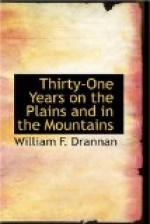Here we stayed over two days, trying to gather some information as to our route, and, strange as it may seem, we could not find a man who would give us any information as to the route we wished to go, which was only about two hundred miles from there.
Trapping had never been done in that region, and these men knew that this was because of hostile Indians there. They were not men of sufficient principle to even intimate to us that the Indians were dangerous in that section, but let us go on to find it out for ourselves, hoping, no doubt, that the Indians would kill us and that there would be so many independent trappers out of the way. From here we took the divide between the Missouri river and the Yellowstone, aiming to keep on high land in order to steer clear, as much as possible, of hostile Indians.
Uncle Kit said he was satisfied that there was a large basin somewhere in that country, but did not know just where or how to find it.
It was in the evening of the fifth day when we came upon a high ridge, and almost due west of us and far below we could see a great valley, since known as Gallatin Valley, where Bozeman, Mont., now stands.
When we came in sight of this beautiful region, Uncle Kit said: “Boys, this is the country I have been looking for, and I’ll assure you if we can get in there and are not molested, we can catch beaver by the hundred.”
We had not been bothered by Indians, nor had we seen any sign of them since we left Fort Benton.
We had been on high ground all of the way, and we thought now when once in this valley we would be entirely out of the way of the Crows, and the Bannocks and Blackfoot Indians would be the only tribes to contend with.
From where we first saw the valley, we started to go down the mountain. The next day, as we got lower, we could see plenty of Indian sign. Striking a canyon, that we thought would lead us down to the valley, we gave it the name of Bridger’s Pass, which name it has to-day. As we neared the valley we saw more Indian sign, and from the amount of it, it seemed that the country must be alive with them. When within about five or six miles of the valley, we saw a band of Indians to our right, on the ridge.
Jim Bridger said: “Boys, they are Crows, and we are in for it.”
They did not come in reach of us, but kept along the ridge above us. We could see by looking ahead that near the mouth of this canyon there was a high cliff of rocks.
We expected to be attacked from those rocks, and we had to be very cautious in passing this point. But to our surprise they did not make the attack. Here we began to see beaver sign in abundance. I don’t think that I ever in my life saw as much of it on the same space of ground as I saw there, for every little stream that emptied into that valley was full of beaver dams.
The Indians kept in sight of us until we struck the valley, which was just at sunset. We traveled until dark, when we stopped and built up a big fire. As soon as our fire was burning good we mounted our horses and rode about one mile on to open ground. Dismounting, we loosened all our saddles, both pack and riding-saddles, and picketed all our horses as close together as we could.




